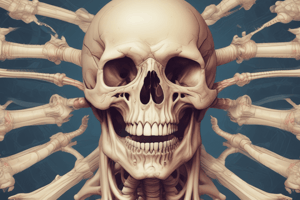Podcast
Questions and Answers
What structural change occurs in the body of the mandible at birth?
What structural change occurs in the body of the mandible at birth?
What is the mandibular angle measurement at three years old?
What is the mandibular angle measurement at three years old?
How does the position of the mandibular canal change from birth to three years old?
How does the position of the mandibular canal change from birth to three years old?
What prominent feature appears in the adult mandible due to the eruption of permanent teeth?
What prominent feature appears in the adult mandible due to the eruption of permanent teeth?
Signup and view all the answers
Which statement is true regarding the development of the sigmoid notch in the mandible?
Which statement is true regarding the development of the sigmoid notch in the mandible?
Signup and view all the answers
What structural change occurs to the mental foramen in the mandible with age?
What structural change occurs to the mental foramen in the mandible with age?
Signup and view all the answers
What describes the change in the sigmoid notch from childhood to old age?
What describes the change in the sigmoid notch from childhood to old age?
Signup and view all the answers
At what age does the mandibular canal change its position relative to the body of the mandible?
At what age does the mandibular canal change its position relative to the body of the mandible?
Signup and view all the answers
What is the angle of the mandible during adulthood?
What is the angle of the mandible during adulthood?
Signup and view all the answers
Which of the following statements regarding the condylar process of the mandible is true in old age?
Which of the following statements regarding the condylar process of the mandible is true in old age?
Signup and view all the answers




